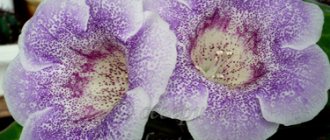Our gardens, as a rule, are dominated by flowers that are well known to us. But sometimes it’s worth taking a closer look at less popular plants - they may turn out to be an unusual attraction on your site.
Such plants include Tuberose or Polianthes (Polianthes tuberosa) - a bulbous perennial from the genus Polyantha and the subfamily Agave. The plant delights with its unusually aromatic and strong smell, reminiscent of the smell of jasmine, gardenia and blooming citrus fruits.
The intensity of the aroma intensifies as evening approaches. Since the smell of tuberose is not only rich and bright, it is also very persistent, so the essential oil obtained from flowers is a valuable raw material used for the production of perfumes.
Polianthes tuberosa was first discovered by researchers in Mexico in the early 1500s. The fragrant lily was one of the first flowering plants brought to Europe, where it gained enormous popularity. Currently, the lily is cultivated in India, Morocco, Hawaii, France and China.
At the top of a tall, strong peduncle there is an inflorescence with rather large creamy-white or pink flowers. The leaves are narrow, collected in a basal rosette. Anyone who knows this perennial and has already dealt with it knows that it is quite difficult to obtain flowers from bulbs of your own cultivation.
Polyanthes has high requirements for cultivation and, above all, thermal requirements. Only by observing a certain temperature regime can you obtain a flowering plant from daughter bulbs. Once planted in the soil in the spring, it is difficult for them to reach maturity. They grow, produce offspring, but do not bloom. Therefore, in order to wait for the wonderful flowering of the fragrant lily, it is better to buy new planting material every season.
Description of tuberose
Tuberose also has a second, scientific name - polyanthes. This flower comes from Central America, where the tropical climate reigns. That is why even photos of tuberose from Russian gardens or native American lands already impress many.
Somewhere these flowers look like orchids, somewhere like roses, and somewhere like lotuses or irises. This diversity is dictated primarily by the large number of varieties of this plant and the complexity of small inflorescences.
Tuberose is a perennial tuberous plant that lives for about 10-15 years. At the same time, its root or tuber contains many nutrients and is protected by scales. That is, even if something happens to the stems and leaves, the plant will preserve itself at the expense of the tubers.
The huge potential for survival makes life much easier for gardeners - after all, if something happens to the above-ground part of the plant, new stems and flowers can always grow.
The stem of the flower is usually dense and strong, about 40-60 cm high. It is on the stem that elegant and multiple inflorescences are formed. The leaves also grow from the tuber along with the stem and have a ray-like shape. Their length is approximately equal to the length of the stem. Both the stem and leaves are dark green in color.
The flowers are medium in size, on separate stalks. The petals have different colors depending on the type and variety of tuberose and can range from white to dark burgundy.
The most popular colors are white, lilac, pink and burgundy. At the time of flowering, the stem increases to 120 cm, and each stem can contain up to 30 flowers.
Interesting! Each tuberose flower blooms for exactly three days. The flower is stored for several days.
Popular varieties of tuberose
Tuberose flowers look like either orchids or irises, but are collected in large spikelets, which resemble gladioli. Tuberose flowers have several distinctive features:
- Fleshy petals that look like wax
- Smooth and bright color
- Strong, original and delicate scent
The appearance of flowers depends on their variety. There are several main varieties of this beautiful plant, from which hybrid varieties are already created:
- Pearl. The plant has white lotus-like flowers.
- Sensation. It has spikelets of flowers with a large number of small inflorescences of pink or lilac color.
- Pink sapphire. The plant has large flowers of a deep purple color.
- Yellow doll. This species has bright and delicate yellow flowers, somewhat reminiscent of double daffodils.
Types and varieties of tuberose with photos
The genus Polyanthes tuberiferous includes about 13 different species. Breeders in our area have adapted to growing only two types of tuberose.
Tuberose latifolia
The flower grows from an oblong tuber up to 5 cm in size. The stem in the center of the bush has wide linear leaves, shining in the sun, gathering into a rosette and enveloping the base of the stem. The spikelet inflorescence looks like grouped white flowers 4 cm long. The aroma during the flowering of the species is barely noticeable. The buds open in mid-spring.
Polyanthes tuberiferous
This is a tall flowering perennial, which consists of a basal rosette of sessile leaves, a bare peduncle and a loose spike-shaped inflorescence. The leaf blades are narrow. Their length does not exceed 6 cm. Tubular white buds, emitting a pleasant aroma, cling to the arrow of the peduncle. One peduncle contains from 10 to 30 buds. Decorative modifications of tuberous polyanthes include the following varieties:
- Pearl is a medium-length plant with double white inflorescences. Prefers warm climates and is planted in pots;
- Sensation - pink-purple perennial tuberose variety;
- Pink sapphire - at the peak of flowering it is covered with lush beautiful flowers. The core is painted in a delicate pink shade, and the petals are framed with a purple border.
Growing methods
Tuberose is grown both in open ground and in greenhouses. In private areas, it is recommended to cover flower beds with tuberose with material in May-April to prevent new stems from freezing.
In any case, before planting tuberose in the soil, the tubers of the plant must be properly prepared. This process consists of several stages:
- The bulbs need to be warmed up. To do this, just wrap them in a warm, damp cloth and leave them at room temperature for a day.
- Before planting, the tubers need to be soaked for several hours in a special solution to stimulate the growth of the bulbs.
- It is necessary to treat the plants with special pest control agents. Tubers are very fleshy parts that retain a lot of moisture and therefore they are often susceptible to fungal diseases or insect attacks.
- Before planting in the ground, the tubers are placed in damp peat or moss. After the bulbs produce small roots, they can be transplanted into the ground.
You can plant tubers in the ground when the soil temperature does not drop below 10 degrees. This is usually the end of April.
Advice. To simplify the cultivation of tuberose, you can purchase seedlings of this plant - already sprouted tubers, completely ready for planting. But this option significantly limits the choice of varieties.
Reproduction and planting
In amateur conditions, tuberose is planted as tubers, and it is better to buy new tubers. Tubers that bloom this year will not bloom again. From one tuber we will get many small ones that will not bloom. Purchasing seeds and then growing bulbs over several years is best left to the professionals.
Reproduction
Propagating tuberose at home is difficult. The tuberose tuber is hypocotyl - it is formed as a result of thickening of the hypocotyl, in which reserves of nutrients accumulate. When purchasing a cluster of tubers, remove the central large tuber that has already flowered.
In countries with warm winters, the plant receives nutrition all year round - the adventitious tubers have time to ripen and accumulate enough nutrients to subsequently produce flowers. In our climate, tuberose blooms at the end of summer and during the short warm days of autumn the tubers do not have time to accumulate enough nutrients for further flowering.
Even when grown in pots and flowering early, the tubers do not have time to ripen sufficiently; in addition to the lack of heat, the plant also experiences a lack of lighting, which is present in the fall. Baby tubers will only be able to produce leaves. Good flowering tubers can be bought; they are brought from warm countries (India, Singapore).
Only owners of well-heated greenhouses can independently propagate tuberose. After ripening, the daughter tubers need to be dried and cleaned. In winter, tubers are stored at a temperature of 10-12 °C. Before spring, the tubers need to be divided, sorted, and the largest ones planted; the rest should be given time to grow. The requirements for a long warm period make the propagation of tuberose unprofitable in our climatic conditions.
Planting in open ground
When to plant tuberose in open ground depends on the region and climate. The plant is very sensitive to frost, so it cannot be planted until mid or late May, and in some regions - until early June. Then, however, it may have too little time to bloom before winter, so it is better to plant it earlier in a pot in a greenhouse and, when it has already formed leaves, plant it in the garden in the spring.
Planting scheme . Number of bulbs per 1 m²: 7-9 pieces.
Planting in pots
Tuberose can be grown in a pot on a windowsill, although it would be better to grow on a balcony or terrace. To do this, plant the tubers in early spring (March-April) in a container filled with flower soil with good drainage at the bottom, and cover with a 2-3 cm thick layer of soil. If you bought a lot of tubers, plant them every 8 cm.
The tuberose substrate is prepared from 3/4 potting soil and 1/4 sand, with a good handful of compost. Pots are selected taking into account the number of bulbs planted:
- with a diameter of 25-30 cm - for 1 onion;
- with a diameter of 40-50 cm - for 3 bulbs.
Despite the fact that the tubers are large, they should not be planted too deep (in this case, the principle of planting a tuber at a depth equal to its triple height does not work), because they take quite a long time to germinate, and deep planting will make the germination period even longer, and the plant may not bloom until winter.
After planting the tubers, the pots are placed in a very bright, warm room with a temperature of 20 °C. We wait with watering until the sprout appears above the ground. After the sprout appears, provide a relatively warm substrate and slightly moist soil. The soil should be slightly moist almost all the time, but it should never be wet, as the bulb will rot before it has time to germinate.
In order not to lower the temperature of the substrate, water it with lukewarm water. If you forgot to water, don’t panic, tuberose can cope with short-term drought.
When the leaves appear, we plant the plants in the ground (at the end of May) or leave them in a pot, placing them on a bright windowsill or balcony at home. By the time it is planted in the ground, tuberose should have a beautiful rosette of green leaves, somewhat similar in appearance to daylily leaves, but much shorter and stiffer.
Soil and fertilizing
Planting tuberose and caring for it in open ground require a special soil composition. Tuberose loves bright places with loose and well-moistened soil. This plant does not tolerate bright sun. The soil should be rich in nutrients and have neutral acidity.
Advice. Before planting, it is better to dilute the soil with turf, moss or peat. This will give the soil more breathability and also help it retain moisture better.
The plant is fed several times a season with mineral fertilizers:
- Before the buds appear
- After the first bud opens
- Several times during the flowering period
In the fall, feeding is stopped.
Growing and care
- Watering. Tuberose requires systematic watering, but not too much. Wet soil is just as dangerous for plant development as too dry soil.
- Remove faded flowers one by one only when necessary.
- Fertilizer . You can fertilize tuberose, but it is not necessary. It is necessary to choose a fertilizer with a high dose of potassium, for example, for flowering plants.
- Autumn care . If the bulbs are planted in open ground, dig them up before the first frost and store them in sand, protected from frost, in the pantry. But it is better to grow them in pots for convenience.
- Wintering . In open ground, tuberose blooms at the end of summer. Then the foliage turns yellow and the bulb goes into a dormant state. Place the pot in a cellar or greenhouse. Store the pot in a dry condition at a temperature of 10-15 °C. Forget about the bulb until spring.
- Care in spring . When the leaves appear again in the spring, place the pot in bright light, resume watering, cover with compost and wait until frost has passed to move it outside.
- Diseases, pests . On a too wet substrate, tuberose can become infected with botrytis, gray mold, and can attract aphids. To combat aphids, spray with soapy water: dilute a tablespoon of liquid laundry soap in 1 liter of water. For greater effectiveness, add 1 tablespoon of vegetable oil.
- Cutting flowers for bouquets . Tuberose is an excellent cut flower. Cut flowers early in the morning as soon as the lower flowers begin to open. After collection, the flower stalks are kept in bouquets for 15 days, provided that they are pruned every 2 days and the water is changed.
Watering
Many people wonder how to water tuberose, because it is a very capricious plant. The main thing when watering is to keep the soil constantly moist, but make sure that it is not too wet.
In sunny and dry weather, watering is carried out every day, in the morning. In moderate weather - once every two days. In rainy weather, this flower is usually not watered.
Propagation of tuberose
Tuberose, like any bulbous plant, reproduces by forming tubers. They are formed after flowering closer to autumn.
For the winter, tubers are usually dug out from open ground, where they can freeze. At the same time, many children can be found on the main bulb. Store the bulbs in dry sand. The following year they are also planted in the ground.
On an industrial scale, tuberose seeds are also used for propagation. However, this method of reproduction is quite complex, as it requires strict adherence to temperature, humidity and lighting conditions.
Most gardeners prefer to propagate this plant by tubers, which brings them great pleasure and joy.
How to choose tubers?
Before you buy tuberose tubers, you should look for large and single ones, because only these can bloom here. If you come across small and knocked down tubers, it is better not to buy them; only leaves will grow from them. Such tubers will be too small to form a flower; in our climate they will not have time to grow before flowering the next year.
The problem with growing tuberose is too little sun in spring and autumn and too low temperatures (tuberose requires at least 20 ° C throughout the growing season, including in the substrate). Therefore, a group of small tubers planted in the garden will produce only green leaves, and in the fall will form an even larger group of small tubers.
They can be dug up and divided, and the largest ones placed in dry peat and stored in winter in a dark, cool room (8-10 ° C), but next season they most likely will not bloom, since they will still be too small and will not have time to bloom. grow again, so it is better to buy new, large, individual tubers every year, preferably from a reliable seller.
Never buy “garlands” of grown tubers. In a year, from a high-quality tuber we will get the same wreaths from individual tubers that will not bloom.
When purchasing, you need to inspect the tuber - what size it is, so that there are no traces of diseases and pests on it. The tuber should be as large as possible; such tubers guarantee that the plant will bloom.











